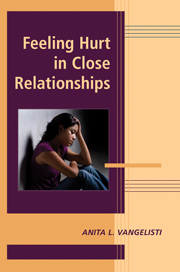Book contents
- Frontmatter
- Contents
- List of Contributors
- Foreword
- PART I INTRODUCTION
- PART II CONCEPTUALIZING HURT
- PART III HURTFUL ACTS
- PART IV HURT IN RELATIONAL CONTEXTS
- 12 Aggression and Victimization in Children's Peer Groups: A Relationship Perspective
- 13 Haven in a Heartless World? Hurt Feelings in the Family
- 14 Hurt Feelings in Adult Friendships
- 15 When Love Hurts: Understanding Hurtful Events in Couple Relationships
- 16 Hurt in Postdivorce Relationships
- PART V HURT IN APPLIED CONTEXTS
- Author Index
- Subject Index
- References
14 - Hurt Feelings in Adult Friendships
from PART IV - HURT IN RELATIONAL CONTEXTS
Published online by Cambridge University Press: 04 August 2010
- Frontmatter
- Contents
- List of Contributors
- Foreword
- PART I INTRODUCTION
- PART II CONCEPTUALIZING HURT
- PART III HURTFUL ACTS
- PART IV HURT IN RELATIONAL CONTEXTS
- 12 Aggression and Victimization in Children's Peer Groups: A Relationship Perspective
- 13 Haven in a Heartless World? Hurt Feelings in the Family
- 14 Hurt Feelings in Adult Friendships
- 15 When Love Hurts: Understanding Hurtful Events in Couple Relationships
- 16 Hurt in Postdivorce Relationships
- PART V HURT IN APPLIED CONTEXTS
- Author Index
- Subject Index
- References
Summary
When people are asked what gives their lives meaning or what gives them joy or happiness, friends are invariably near the top, if not at the top of the list (see Fehr, 1996). When people's day-to-day interactions are tracked and they are asked, at random times, to report on what they are doing at the moment, with whom, and how they feel, it is time with friends that is associated with the greatest enjoyment and pleasure – even more so than time spent with family or alone (Larson & Bradney, 1988). Although friendship has frequently been described as the “neglected relationship,” the research that is accumulating clearly shows that friendships are cherished, valued, and of central importance in people's lives. Indeed, when Berscheid and colleagues (1989) asked undergraduate students to name “their closest, deepest, most involved, and most intimate relationship,” 47% nominated a romantic relationship; a substantial 36% named a friend – family relationships, listed by only 14% of respondents, ranked third (Berscheid, Snyder, & Omoto, 1989). Thus, the dominant melody line in friendship is one of intimacy, closeness, happiness, and enjoyment. However, there is also another, contrasting melody line – a dark and lugubrious counterpoint. When Leary and colleagues (1998) asked undergraduate students to describe “a specific time when someone else said or did something that hurt your feelings,” that “someone” was most likely to be a close friend (39%), followed by a romantic partner (32%); acquaintances (12%) and family members (10%) were listed much less frequently (Leary, Springer, Negel, Ansell, & Evans, 1998).
- Type
- Chapter
- Information
- Feeling Hurt in Close Relationships , pp. 288 - 312Publisher: Cambridge University PressPrint publication year: 2009
References
- 1
- Cited by



